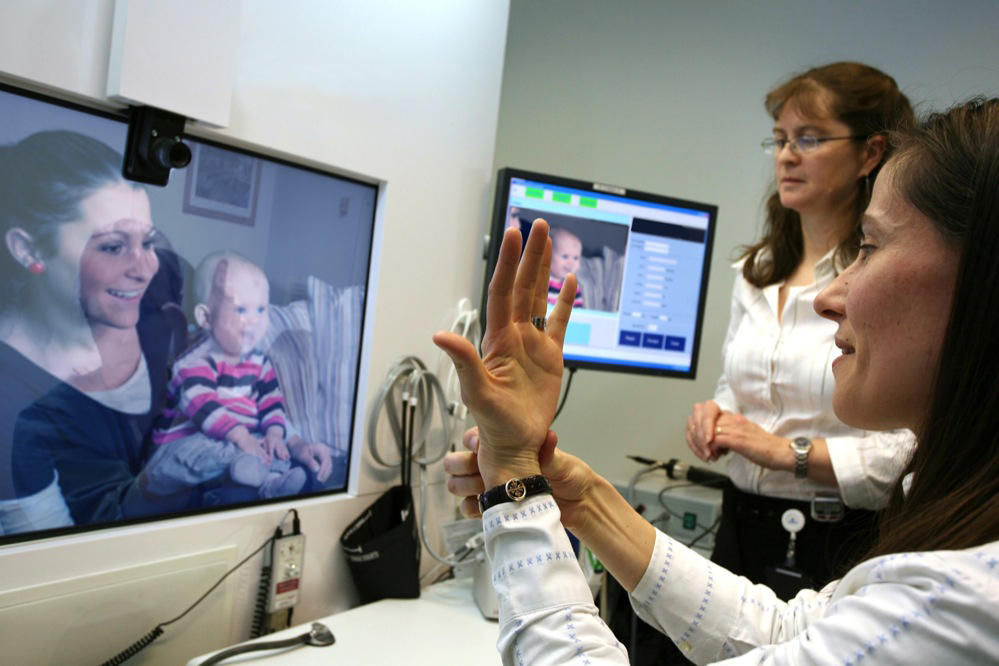Key Takeaways:
- Telehealth therapy revolutionizes access to healthcare professionals.
- Teletherapy overcomes geographical limitations and provides specialized care.
- Telehealth therapy removes physical access barriers and preserves continuity of care.
- Telehealth therapy offers convenience, flexibility, and reduces wait times for appointments.
- Teletherapy enhances patient privacy and confidentiality.
- Teletherapy increases access to mental health services and addresses stigma.
- Teletherapy expands treatment options for diverse populations.
- Telehealth therapy optimizes healthcare delivery through technology.
- Virtual consultations and AI-powered platforms improve patient experience.
- Integrating telemedicine into existing healthcare systems enhances quality of care.
1. Breaking Down Barriers: The Revolution of Telehealth Therapy
Connecting Patients with Healthcare Professionals
Telehealth therapy, also known as teletherapy or telemedicine, has revolutionized the way patients access healthcare professionals. With the advancement of technology, individuals can now connect with therapists, psychologists, psychiatrists, and other healthcare providers through virtual platforms. The barriers of distance and time zones are no longer obstacles when it comes to seeking professional help and advice.
Prior to the widespread use of telehealth therapy, individuals in rural areas or those with limited mobility faced difficulties in accessing healthcare services. They often had to travel long distances to see a specialist or wait for extended periods to secure an appointment. However, telehealth therapy has made it possible for patients to connect with healthcare professionals remotely, bringing care directly into their homes.
Overcoming Geographical Limitations
One of the key advantages of telehealth therapy is its ability to overcome geographical limitations. In remote areas where healthcare facilities are scarce, teletherapy provides a lifeline for individuals in need of mental health support. Patients no longer have to endure long journeys or face the challenges of finding transportation to reach their therapists.
Moreover, telehealth therapy enables individuals to access specialized care that may not be available locally. In regions where there is a shortage of mental health professionals, teletherapy allows patients to connect with therapists from different locations. This not only improves access to care but also ensures that patients receive the most appropriate treatment for their specific needs.
Removing Physical Access Barriers
Telehealth therapy removes physical access barriers that may prevent individuals from seeking help. For patients with disabilities or limited mobility, attending in-person therapy sessions can be challenging. Teletherapy eliminates the need for transportation and makes therapy accessible to individuals in their own homes.
Furthermore, telehealth therapy has been particularly beneficial during times of crisis, such as the COVID-19 pandemic. Social distancing measures and lockdown restrictions made traditional in-person therapy sessions impractical or impossible. However, teletherapy ensured that individuals could continue their therapy sessions without interruption, preserving the continuity of care.
2. The Benefits of Telehealth Therapy: Improving Patient Experience
Convenience and Flexibility
One of the primary benefits of telehealth therapy is the convenience and flexibility it offers to patients. With teletherapy, individuals can schedule appointments that fit within their busy lives, eliminating the need to take time off work or rearrange commitments. Patients can access therapy sessions from the comfort of their own homes, removing the stress of commuting and waiting in crowded waiting rooms.
Moreover, telehealth therapy provides patients with greater control over their treatment. It allows them to choose therapists based on their specific needs and preferences, regardless of geographical location. This freedom of choice empowers patients to find the best possible match for their therapy journey.
Reducing Wait Times and Improving Access to Care
Another significant benefit of telehealth therapy is the reduction in wait times for appointments. In many healthcare systems, particularly those with limited mental health resources, patients often face long waiting periods to see a therapist. However, with the advent of teletherapy, individuals can quickly connect with healthcare professionals, minimizing the delay in receiving treatment.
This reduction in wait times is crucial, as early intervention is often key in mental health. By providing timely access to therapy services, telehealth therapy can help prevent conditions from worsening and promote better mental well-being.
Enhancing Patient Privacy and Confidentiality
Privacy and confidentiality are fundamental aspects of therapy. Telehealth therapy takes these concerns seriously and employs various measures to protect patient information. Virtual platforms used for teletherapy sessions are encrypted and secure, ensuring that patient data remains confidential.
Furthermore, teletherapy sessions conducted in the privacy of an individual’s home can help alleviate the stigma associated with seeking mental health support. The absence of physical presence in a waiting room reduces the fear of being seen or judged by others. This added layer of privacy encourages more individuals to seek therapy without fear of discrimination or negative repercussions.
3. Empowering Mental Health: Teletherapy’s Impact on Behavioral Health
Increasing Access to Mental Health Services
Teletherapy has played a crucial role in increasing access to mental health services, particularly for underserved populations. Many individuals, especially those residing in rural or underprivileged areas, face significant barriers in accessing mental health care. Telehealth therapy bridges this gap and enables individuals to receive the support they need, regardless of their geographical location.
By expanding access to mental health services, teletherapy helps reduce the burden on already overwhelmed healthcare systems. It eases the strain on in-person services and allows mental health professionals to reach a wider audience through virtual platforms.
Addressing Stigma Through Remote Counseling
Stigma surrounding mental health issues often prevents individuals from seeking therapy. Teletherapy provides a solution to this problem by offering remote counseling services. With the option to connect with therapists from the privacy of their own homes, individuals can seek help without the fear of judgment from others.
This remote counseling approach also benefits populations who face cultural or social barriers to seeking therapy. Teletherapy allows individuals to access therapists who are sensitive to their unique needs and experiences, promoting a more inclusive and culturally competent therapeutic environment.
Expanding Treatment Options for Diverse Populations
Teletherapy has expanded treatment options for diverse populations who may have specific requirements or preferences. For individuals with disabilities or chronic illnesses, accessing in-person therapy sessions can be challenging. Telehealth therapy eliminates physical barriers and makes therapy more accessible to these populations.
Additionally, teletherapy caters to individuals who may prefer certain types of therapy that are not readily available in their local area. Through virtual platforms, patients can connect with therapists who specialize in specific modalities or treatment approaches, opening up a wider range of treatment options.
4. Technology and Telehealth Therapy: Optimizing Healthcare Delivery
Utilizing Innovative Tools for Virtual Consultations
Technology plays a significant role in optimizing healthcare delivery through telehealth therapy. Virtual consultations are made possible through video conferencing tools that allow real-time communication between healthcare professionals and patients. These platforms often include additional features such as chat functions, document sharing, and collaborative whiteboards to enhance the therapeutic experience.
Moreover, advancements in virtual reality (VR) technology hold immense potential for telehealth therapy. VR can create immersive therapeutic environments or simulate scenarios to aid in exposure therapy for individuals with anxiety disorders or phobias. By integrating VR technology into teletherapy, healthcare professionals can enhance the effectiveness of treatment and improve patient outcomes.
Leveraging Artificial Intelligence in Telehealth Platforms
Artificial intelligence (AI) is revolutionizing healthcare, and telehealth therapy is no exception. AI-powered chatbots and virtual assistants can help patients navigate through self-help resources, answer frequently asked questions, and provide support between therapy sessions. These tools act as a virtual companion, enhancing patient engagement and encouraging adherence to treatment plans.
Additionally, AI algorithms can analyze data from teletherapy sessions to identify patterns, predict patient needs, and personalize treatment plans. This advanced analytics can aid therapists in tailoring interventions to individual patients, resulting in more targeted and effective therapy.
Integrating Telemedicine into Existing Healthcare Systems
Telehealth therapy is not meant to replace traditional in-person healthcare services; rather, it is intended to complement and enhance existing systems. Integrating telemedicine into healthcare systems can help address the growing demand for mental health services and overcome resource constraints.
By integrating teletherapy with electronic health records (EHR) and other health information systems, healthcare providers can ensure seamless communication and continuity of care. This integration allows therapists to access patients’ medical history and provide informed, personalized treatment plans.
Furthermore, collaboration between telehealth therapy providers and in-person healthcare professionals enhances the overall quality of care. It facilitates referrals, coordination of treatment plans, and a holistic approach to patient well-being.
Conclusion
Telehealth therapy has emerged as a powerful tool in improving access to mental health services and transforming healthcare delivery. By breaking down geographical barriers, reducing wait times, and enhancing patient privacy, teletherapy has made therapy more convenient and accessible to individuals in need. It has empowered individuals to seek mental health support without fear of stigma and provided treatment options for diverse populations.
Technology has played a vital role in optimizing telehealth therapy, with innovative tools like virtual consultations and AI-powered platforms enhancing the therapeutic process. Integrating telemedicine into existing healthcare systems ensures seamless communication and collaboration between teletherapy providers and traditional healthcare professionals.
The power of telehealth therapy lies in its ability to enhance access to mental health services, improve patient experience, and transform the way healthcare is delivered. As technology continues to advance, teletherapy will undoubtedly play an increasingly significant role in promoting mental well-being and shaping the future of healthcare.


